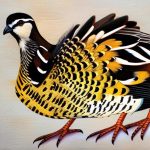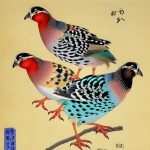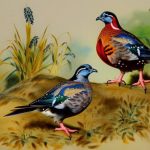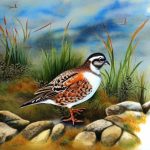The California Valley Quail, also known as the California Quail, is a small ground-dwelling bird native to the western United States. These birds are known for their striking appearance, with a plump body, forward-drooping crest, and intricate black and white markings on their face and throat. They are popular among bird enthusiasts and hunters alike for their beautiful plumage and delicious meat.
California Valley Quail are social birds that typically live in coveys, which are small flocks consisting of a few breeding pairs and their offspring. They are ground foragers, feeding on seeds, leaves, and insects, and are often found in open woodlands, brushy areas, and agricultural fields. These birds are known for their distinctive “chi-ca-go” call, which they use to communicate with each other and to alert the covey of potential danger.
In recent years, California Valley Quail have become popular among aviculturists for breeding and raising in captivity. Their hardy nature, beautiful appearance, and relatively easy care requirements make them an attractive option for hobbyists and small-scale breeders. In this article, we will explore the process of selecting breeding pairs, housing and caring for them, the breeding and incubation process, raising chicks, as well as health and nutrition considerations for breeding pairs. We will also provide tips for successful breeding and rearing of California Valley Quail.
Table of Contents
- 1 Selecting Breeding Pairs
- 2 Housing and Care for Breeding Pairs
- 3 Breeding and Incubation Process
- 4 Raising Chicks
- 5 Health and Nutrition for Breeding Pairs
- 6 Tips for Successful Breeding and Rearing of California Valley Quail
- 7 FAQs
- 7.1 What is a breeding pair of California Valley Quail?
- 7.2 How do you identify a breeding pair of California Valley Quail?
- 7.3 What is the breeding season for California Valley Quail?
- 7.4 How do breeding pairs of California Valley Quail care for their offspring?
- 7.5 What are the ideal conditions for breeding pairs of California Valley Quail?
- 7.6 How can I attract breeding pairs of California Valley Quail to my property?
Key Takeaways
- California Valley Quail are popular game birds known for their hardiness and adaptability
- When selecting breeding pairs, look for healthy, active birds with no signs of disease or deformities
- Provide breeding pairs with spacious, well-ventilated housing and a balanced diet for optimal breeding conditions
- The breeding and incubation process involves collecting and storing eggs, as well as maintaining proper temperature and humidity levels
- Raising chicks requires a brooder with heat lamps, proper nutrition, and protection from predators and extreme weather
- Health and nutrition for breeding pairs should include a diet high in protein and calcium, as well as regular health check-ups
- Successful breeding and rearing of California Valley Quail requires careful monitoring of breeding pairs, proper nutrition, and a clean, stress-free environment
Selecting Breeding Pairs
Selecting the right breeding pairs is crucial for successful quail breeding. When choosing breeding pairs, it is important to consider the birds’ health, temperament, and genetic diversity. Look for birds that are active, alert, and in good physical condition. Avoid birds that show signs of illness or deformities, as these traits can be passed on to their offspring.
Genetic diversity is also important when selecting breeding pairs. Inbreeding can lead to genetic abnormalities and reduced fertility in offspring. To avoid this, choose birds that are not closely related and come from different bloodlines. This will help maintain the overall health and vigor of the quail population.
Temperament is another important factor to consider when selecting breeding pairs. Look for birds that are calm and non-aggressive towards each other. Aggressive behavior can lead to injuries and stress, which can negatively impact breeding success.
When selecting breeding pairs, it is also important to consider the birds’ reproductive history. Look for birds that have successfully bred and raised chicks in the past. This can be an indication of their fertility and parenting abilities.
Overall, selecting breeding pairs requires careful observation and consideration of the birds’ physical health, genetic diversity, temperament, and reproductive history. By choosing the right pairs, you can increase the likelihood of successful breeding and healthy offspring.
Housing and Care for Breeding Pairs
Proper housing and care are essential for maintaining the health and well-being of breeding pairs. When housing California Valley Quail, it is important to provide them with a spacious and secure enclosure that allows for natural behaviors such as dust bathing, foraging, and roosting.
The enclosure should be constructed with sturdy wire mesh to prevent predators from gaining access to the birds. It should also have a solid roof to protect the quail from aerial predators such as hawks and owls. Additionally, the enclosure should have adequate ventilation to prevent the buildup of ammonia from droppings.
Inside the enclosure, provide plenty of hiding spots such as shrubs, brush piles, or wooden shelters to allow the quail to escape from potential threats and seek shelter from extreme weather conditions. It is also important to provide a variety of perches at different heights to encourage natural roosting behavior.
In terms of care, breeding pairs should be provided with a balanced diet consisting of high-quality game bird feed supplemented with fresh greens, seeds, and insects. Clean, fresh water should be available at all times.
Regular health checks are also important to monitor the breeding pairs for any signs of illness or injury. This includes checking for parasites such as mites or lice, as well as keeping an eye out for any changes in behavior or appetite.
By providing a spacious and secure enclosure, a balanced diet, and regular health checks, you can ensure that your breeding pairs are healthy and comfortable, which will ultimately contribute to successful breeding and rearing of California Valley Quail.
Breeding and Incubation Process
Breeding California Valley Quail in captivity requires careful management of breeding pairs and proper incubation of eggs. The breeding season typically begins in late winter or early spring when daylight hours increase, triggering hormonal changes in the birds that stimulate mating behavior.
During the breeding season, it is important to closely monitor the breeding pairs for signs of mating behavior such as courtship displays, mating calls, and nest building. Once mating has occurred, the female will begin laying eggs in a shallow depression lined with grass and feathers.
After the eggs have been laid, it is important to collect them daily to prevent them from being damaged or eaten by the quail or other animals in the enclosure. The eggs should be stored in a cool, dry place with a consistent temperature until they are ready to be incubated.
When it comes to incubating quail eggs, it is important to use a reliable incubator that maintains a consistent temperature and humidity level. The eggs should be placed in the incubator with the pointed end facing downward and turned several times a day to ensure proper development.
The incubation period for California Valley Quail eggs is approximately 21 days. During this time, it is important to monitor the temperature and humidity levels in the incubator to ensure optimal conditions for embryo development.
Once the eggs begin to hatch, it is important to provide a warm and safe environment for the chicks to dry off and gain strength before being introduced to the rest of the flock. Proper management of the breeding and incubation process is essential for successful hatching and rearing of healthy quail chicks.
Raising Chicks
Raising California Valley Quail chicks requires careful attention to their nutritional needs, socialization, and protection from predators. When the chicks hatch, they should be kept in a warm brooder with access to clean water and high-quality game bird starter feed.
The brooder should be equipped with a heat source such as a heat lamp or heating pad to maintain a temperature of around 95 degrees Fahrenheit during the first week of life. The temperature can then be gradually reduced by 5 degrees each week until the chicks are fully feathered.
In addition to providing a warm environment and proper nutrition, it is important to socialize the chicks with gentle handling and interaction. This will help them become more tame and accustomed to human presence, which can be beneficial if they are intended for release into the wild or for exhibition purposes.
As the chicks grow, they can be gradually introduced to the rest of the flock under close supervision to prevent aggression from older birds. It is important to provide plenty of hiding spots and perches within the enclosure to allow the chicks to escape from potential threats until they are fully integrated into the flock.
Protection from predators is also crucial when raising quail chicks. The brooder should be secure from potential threats such as rodents, snakes, and other animals that may harm or stress the chicks. Once they are old enough to be introduced to the main enclosure, ensure that it is predator-proofed with sturdy wire mesh and a solid roof.
By providing proper nutrition, socialization, protection from predators, and gradual integration into the flock, you can ensure that your California Valley Quail chicks grow up healthy and well-adjusted.
Health and Nutrition for Breeding Pairs

Maintaining the health and nutrition of breeding pairs is essential for successful reproduction and raising of healthy offspring. Providing a balanced diet consisting of high-quality game bird feed supplemented with fresh greens, seeds, and insects is crucial for meeting their nutritional needs.
In addition to a balanced diet, it is important to provide access to clean, fresh water at all times. Dehydration can lead to decreased egg production and poor hatching rates in breeding pairs. Regularly clean water containers to prevent contamination from droppings or debris.
Regular health checks are also important for monitoring the breeding pairs for any signs of illness or injury. Look for changes in behavior such as lethargy or decreased appetite, as well as physical symptoms such as abnormal droppings or feather loss. If any signs of illness are observed, consult with a veterinarian experienced in avian medicine for proper diagnosis and treatment.
Preventative measures such as parasite control should also be implemented to maintain the health of breeding pairs. Regularly inspect the birds for signs of external parasites such as mites or lice, which can cause discomfort and stress.
Overall, maintaining the health and nutrition of breeding pairs requires providing a balanced diet, access to clean water, regular health checks, and preventative measures against parasites. By ensuring that your quail are healthy and well-nourished, you can increase the likelihood of successful breeding and rearing of California Valley Quail.
Tips for Successful Breeding and Rearing of California Valley Quail
Successfully breeding and rearing California Valley Quail requires careful management of breeding pairs, proper incubation of eggs, raising healthy chicks, and maintaining the overall health of the flock. Here are some tips for achieving success in quail breeding:
1. Selecting Breeding Pairs: Choose birds that are in good physical condition, genetically diverse, calm in temperament, and have a successful reproductive history.
2. Housing and Care: Provide a spacious and secure enclosure with plenty of hiding spots and perches. Offer a balanced diet supplemented with fresh greens, seeds, and insects. Conduct regular health checks and preventative parasite control.
3. Breeding Process: Monitor breeding pairs for signs of mating behavior such as courtship displays and nest building. Collect eggs daily to prevent damage or predation.
4. Incubation: Use a reliable incubator with consistent temperature and humidity levels. Turn eggs several times a day until they hatch.
5. Raising Chicks: Provide a warm brooder with access to clean water and high-quality game bird starter feed. Socialize chicks through gentle handling and interaction. Protect them from predators during integration into the main flock.
By following these tips and providing proper care for your California Valley Quail breeding pairs, you can increase the likelihood of successful reproduction and rearing of healthy offspring. With careful management and attention to their needs, you can enjoy the beauty of these birds while contributing to their conservation efforts in captivity.
If you’re interested in breeding pairs of California Valley Quail, you may also want to consider creating a suitable environment for them to thrive. A well-designed chicken coop can provide the necessary shelter and protection for these birds. For inspiration on how to create a comfortable and functional coop, check out this article on PoultryWizard that discusses different coop designs, including options for garden and farmhouse settings. Creating a safe and comfortable space for your quail can contribute to their overall health and well-being.
FAQs
What is a breeding pair of California Valley Quail?
A breeding pair of California Valley Quail consists of a male and a female quail that are kept together for the purpose of producing offspring.
How do you identify a breeding pair of California Valley Quail?
Male California Valley Quail, also known as cocks, can be identified by their distinctive black face and throat with a white stripe above the eye. Females, also known as hens, have a more subdued coloration with a smaller plume on their head.
What is the breeding season for California Valley Quail?
The breeding season for California Valley Quail typically occurs in the spring and early summer, with peak breeding activity taking place from April to June.
How do breeding pairs of California Valley Quail care for their offspring?
After the female quail lays her eggs in a shallow depression on the ground, both the male and female quail take turns incubating the eggs for about 21 days. Once the chicks hatch, both parents play a role in caring for and protecting the young.
What are the ideal conditions for breeding pairs of California Valley Quail?
Breeding pairs of California Valley Quail thrive in open grasslands, brushy areas, and agricultural fields with access to water sources. They prefer areas with low to moderate shrub cover for nesting and protection.
How can I attract breeding pairs of California Valley Quail to my property?
To attract breeding pairs of California Valley Quail, provide suitable habitat with a mix of open areas and low shrubs, as well as a reliable water source. Additionally, minimizing disturbances and providing supplemental food sources can help attract and support quail populations.
Meet Walter, the feathered-friend fanatic of Florida! Nestled in the sunshine state, Walter struts through life with his feathered companions, clucking his way to happiness. With a coop that’s fancier than a five-star hotel, he’s the Don Juan of the chicken world. When he’s not teaching his hens to do the cha-cha, you’ll find him in a heated debate with his prized rooster, Sir Clucks-a-Lot. Walter’s poultry passion is no yolk; he’s the sunny-side-up guy you never knew you needed in your flock of friends!







